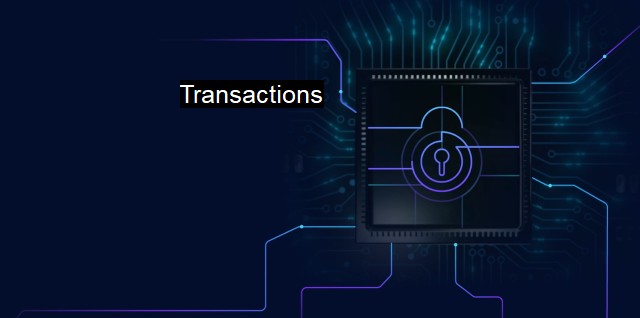What are Transactions?
The Vital Importance of Cybersecurity in Today's Digital Transactions Era: Protecting Sensitive Information with Encryption
Transactions, in the context of cybersecurity and antivirus frameworks, are procedures undergoing within digital domains where data, funds, or even just connection requests are being transferred from one system to another. What makes a transaction unique in the larger sphere of data operations is its atomic nature, meaning that within a single transaction, various operations occur that are interdependent. Under an ideal scenario, they are expected to perform successfully together. But If any part of that transaction fails, the entire transaction may require cancellation, thereby providing a built-in safety measure.Digital transactions are observed in nearly every sector, and it comes as no surprise that they are a focal point for cybersecurity efforts. They are literally the veins of the digital world circulating critical information which, if managed poorly or attacked successfully, could lead to enormous mental, financial, or infrastructural damage. Whether it's a consumer buying goods online using a digital payment system or an multinational corporation managing critical data across its global networks, transactions are identifiable instances where valuable data is alive and in motion.
To robustly secure these transactions, professionals of cybersecurity utilise certain strategies and technologies adopted by industries worldwide. At its core, transaction security includes encryption, secure network systems, and secure systems of identification. Encryption transforms data into coded messages that require designated cryptographic keys to unlock. This method secures the data whether it is stored (at rest) or is being transferred during a transaction (in transit). On its own encryption might not be sufficient.
In addition to encryption, the network through which transactions travel must be equally secure. This principle is implemented with the help of firewalls, secure socket layers (SSL), transport layer security (TLS), and various other network safeguarding technologies. Operated and monitored meticulously, these tools help ensure that the path travelled by a transaction is safer from interceptors who could capture, divert, misdirect, or corrupt these packets of data.
To fortify transaction security further, cybersecurity techniques often include some form of secure personal identification. Techniques could range from password protections to more high-end biometric identification methods like fingerprints, facial patterns, even DNA coding in some cases.
Utmost security measures do not necessarily guarantee foolproof transactions, primarily due to an ever-adapting landscape of cyber threats. if a malicious software or 'malware' infects a computer, it can jeopardize transactional security. Malware renders the antivirus software irrelevant and infiltrates the operating systems to steal, compromise, or damage the data. They can result in exposing personal identification information, account details etc., to cybercriminals.
In such an environment of increased threats, experts increasingly rely on advanced antivirus software. These specifically crafted, sophisticated tools protect devices that observe heavy transactions and share critical information. Antivirus tools screen verifies and constantly monitor to detect signs of malicious software. They also regularly examine system files and memory for patterns that match known malware, isolating them in quarantined storage if found.
Data breaches leading to compromised transactions have led to global concerns, causing massive financial losses to numerous organizations. One needs to understand that cybersecurity for transactions doesn't stop after merely putting advanced antivirus software in place. It necessitates continuous monitoring and fine tuning, employing latest security patches and keeping abreast with current attack patterns and cyber threats. Not doing so puts the transactions, and overall cyber infrastructure, at a high risk.
Even those who are confident in their antivirus defenses learn the hard way that cyber threats evolve continuously. Systems are being assaulted by malware crafted to bypass traditional detection methods. Conversely, security technologies are also evolving – cyber intelligence, behavioral analysis, machine learning, and big data analytics are transforming the world of antivirus capability to give them an edge.
It becomes quite clear that the security of transactions in the world of cybersecurity is of paramount importance, and is aptly complex involving a huge range of security tools and techniques. It is not merely about securing the data, but about setting up resilient ecosystems that are not just self-defensive but also dynamic and ever-evolving to maintain pace with potential threats.

| | A | | | B | | | C | | | D | | | E | | | F | | | G | | | H | | | I | | | J | | | K | | | L | | | M | |
| | N | | | O | | | P | | | Q | | | R | | | S | | | T | | | U | | | V | | | W | | | X | | | Y | | | Z | |
| | 1 | | | 2 | | | 3 | | | 4 | | | 7 | | | 8 | | |||||||